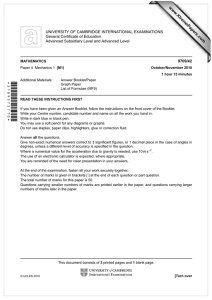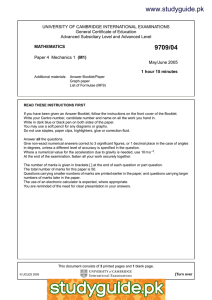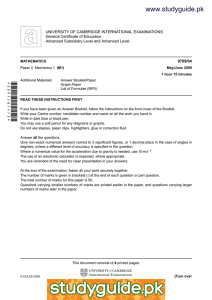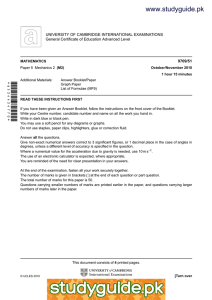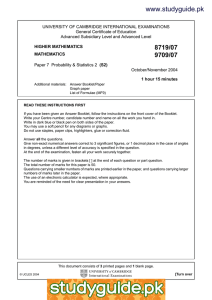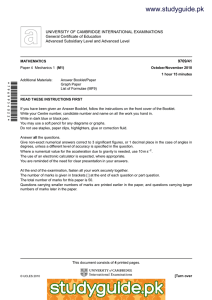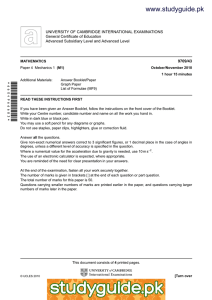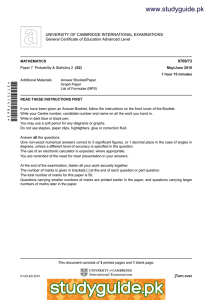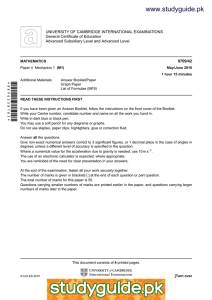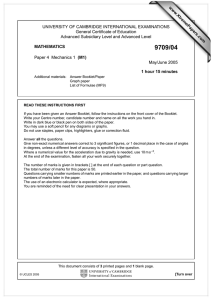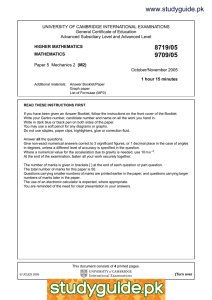www.studyguide.pk
advertisement
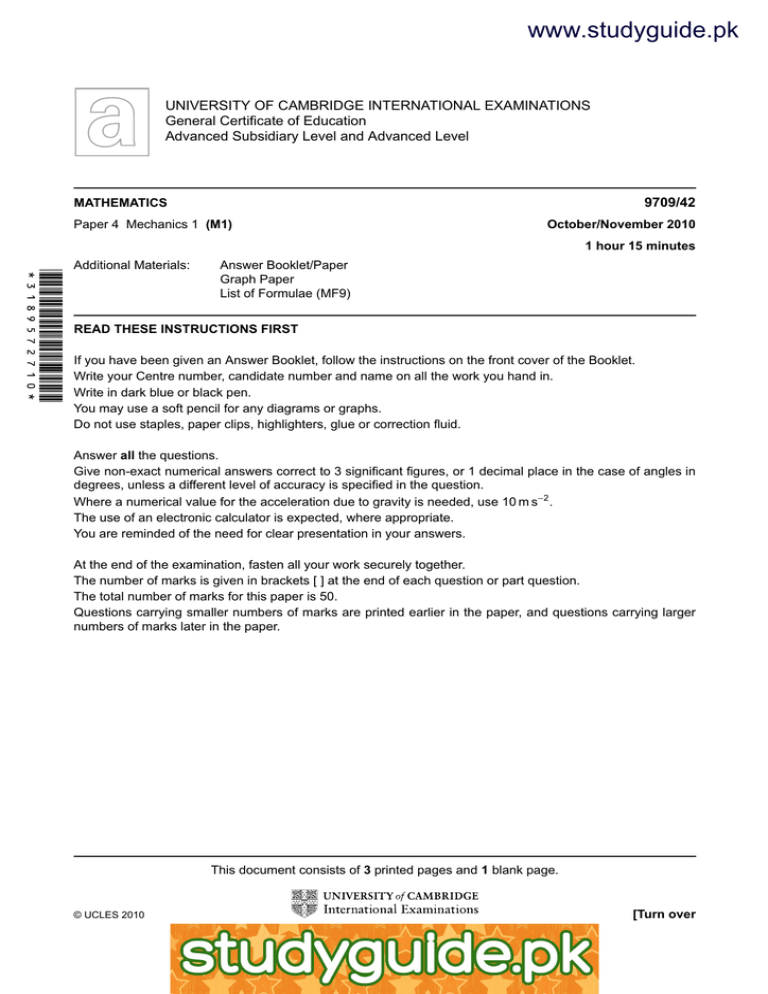
www.studyguide.pk UNIVERSITY OF CAMBRIDGE INTERNATIONAL EXAMINATIONS General Certificate of Education Advanced Subsidiary Level and Advanced Level 9709/42 MATHEMATICS Paper 4 Mechanics 1 (M1) October/November 2010 1 hour 15 minutes *3189572710* Additional Materials: Answer Booklet/Paper Graph Paper List of Formulae (MF9) READ THESE INSTRUCTIONS FIRST If you have been given an Answer Booklet, follow the instructions on the front cover of the Booklet. Write your Centre number, candidate number and name on all the work you hand in. Write in dark blue or black pen. You may use a soft pencil for any diagrams or graphs. Do not use staples, paper clips, highlighters, glue or correction fluid. Answer all the questions. Give non-exact numerical answers correct to 3 significant figures, or 1 decimal place in the case of angles in degrees, unless a different level of accuracy is specified in the question. Where a numerical value for the acceleration due to gravity is needed, use 10 m s−2 . The use of an electronic calculator is expected, where appropriate. You are reminded of the need for clear presentation in your answers. At the end of the examination, fasten all your work securely together. The number of marks is given in brackets [ ] at the end of each question or part question. The total number of marks for this paper is 50. Questions carrying smaller numbers of marks are printed earlier in the paper, and questions carrying larger numbers of marks later in the paper. This document consists of 3 printed pages and 1 blank page. [Turn over © UCLES 2010 www.XtremePapers.net www.studyguide.pk 2 1 A block of mass 400 kg rests in limiting equilibrium on horizontal ground. A force of magnitude 2000 N acts on the block at an angle of 15◦ to the upwards vertical. Find the coefficient of friction between the block and the ground, correct to 2 significant figures. [5] 2 A cyclist, working at a constant rate of 400 W, travels along a straight road which is inclined at 2◦ to the horizontal. The total mass of the cyclist and his cycle is 80 kg. Ignoring any resistance to motion, find, correct to 1 decimal place, the acceleration of the cyclist when he is travelling (i) uphill at 4 m s−1 , (ii) downhill at 4 m s−1 . [5] 3 6N FN P a° 5N FN A particle P is in equilibrium on a smooth horizontal table under the action of four horizontal forces of magnitudes 6 N, 5 N, F N and F N acting in the directions shown. Find the values of α and F. [6] 4 A block of mass 20 kg is pulled from the bottom to the top of a slope. The slope has length 10 m and is inclined at 4.5◦ to the horizontal. The speed of the block is 2.5 m s−1 at the bottom of the slope and 1.5 m s−1 at the top of the slope. (i) Find the loss of kinetic energy and the gain in potential energy of the block. [3] (ii) Given that the work done against the resistance to motion is 50 J, find the work done by the pulling force acting on the block. [2] (iii) Given also that the pulling force is constant and acts at an angle of 15◦ upwards from the slope, find its magnitude. [2] 5 Particles P and Q are projected vertically upwards, from different points on horizontal ground, with velocities of 20 m s−1 and 25 m s−1 respectively. Q is projected 0.4 s later than P. Find (i) the time for which P’s height above the ground is greater than 15 m, [3] (ii) the velocities of P and Q at the instant when the particles are at the same height. [5] © UCLES 2010 9709/42/O/N/10 www.XtremePapers.net www.studyguide.pk 3 6 v (m s–1) V O 2.5 4.5 14.5 t (s) The diagram shows the velocity-time graph for a particle P which travels on a straight line AB, where v m s−1 is the velocity of P at time t s. The graph consists of five straight line segments. The particle starts from rest when t = 0 at a point X on the line between A and B and moves towards A. The particle comes to rest at A when t = 2.5. (i) Given that the distance XA is 4 m, find the greatest speed reached by P during this stage of the motion. [2] In the second stage, P starts from rest at A when t = 2.5 and moves towards B. The distance AB is 48 m. The particle takes 12 s to travel from A to B and comes to rest at B. For the first 2 s of this stage P accelerates at 3 m s−2 , reaching a velocity of V m s−1 . Find 7 (ii) the value of V , [2] (iii) the value of t at which P starts to decelerate during this stage, [3] (iv) the deceleration of P immediately before it reaches B. [2] A particle P travels in a straight line. It passes through the point O of the line with velocity 5 m s−1 at time t = 0, where t is in seconds. P’s velocity after leaving O is given by (0.002t3 − 0.12t2 + 1.8t + 5) m s−1 . The velocity of P is increasing when 0 < t < T1 and when t > T2 , and the velocity of P is decreasing when T1 < t < T2 . (i) Find the values of T1 and T2 and the distance OP when t = T2 . [7] (ii) Find the velocity of P when t = T2 and sketch the velocity-time graph for the motion of P. [3] © UCLES 2010 9709/42/O/N/10 www.XtremePapers.net www.studyguide.pk 4 BLANK PAGE Permission to reproduce items where third-party owned material protected by copyright is included has been sought and cleared where possible. Every reasonable effort has been made by the publisher (UCLES) to trace copyright holders, but if any items requiring clearance have unwittingly been included, the publisher will be pleased to make amends at the earliest possible opportunity. University of Cambridge International Examinations is part of the Cambridge Assessment Group. Cambridge Assessment is the brand name of University of Cambridge Local Examinations Syndicate (UCLES), which is itself a department of the University of Cambridge. 9709/42/O/N/10 www.XtremePapers.net
